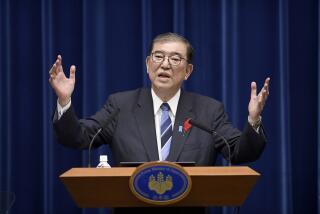Policy Disputes Weaken Japan’s Shaky Coalition
- Share via
TOKYO — Japan’s rainbow coalition confronted the threat of a breakup Saturday as leaders of its eight parties failed to agree on policies that a successor to outgoing Prime Minister Morihiro Hosokawa should follow.
They promised to choose a new leader from within their ranks and elect him prime minister by the end of this week. But quarrels among themselves undermined the credibility of their pledge.
Leaders of the Japan Renewal Party and the Buddhist-backed Komei (Clean Government) Party insisted that without a new policy agreement, they would balk at forming a new Cabinet within the present framework of seven parties in the lower house and eight in the upper chamber of Parliament. But the Socialists, whose leftist policies repeatedly hampered Hosokawa during his eight months in office, rejected any new agreement.
At stake are tax reforms, considered essential to support measures to end a three-year recession, and how a new Cabinet will deal with U.S.-Japan economic frictions and continuing fears of a North Korean nuclear weapons program.
Hosokawa’s shock resignation came Friday, but he will stay on as caretaker until his successor is chosen.
Failure of the eight parties to agree on a new leader would fracture the coalition and force its segments to turn to the Liberal Democrats for help. Even united, the coalition holds only a five-seat majority in the lower house, which elects the prime minister.
Meanwhile, new splits within the coalition--as well as the possibility of one within the Liberal Democratic Party, which lost its 38-year grasp on power last summer--appeared one after another.
Hosokawa officially broke his once close relationship with Chief Cabinet Secretary Masayoshi Takemura, head of the New Party Harbinger, by removing 40 of his followers from a joint parliamentary negotiating body and registering them in a new group under his sole leadership. Later, however, about 10 of the Hosokawa followers indicated they would break with him and join Takemura.
Leaders of the Renewal and Komei parties again put out feelers to former Foreign Minister Michio Watanabe, the leader of the Liberal Democrats’ third-largest faction, urging him to bolt his party and head a new coalition as prime minister. On Saturday, Watanabe all but accepted the invitation.
Asked what he would do if support for him as a non-Liberal Democrat prime minister emerged, Watanabe replied:
“Any member of Parliament would accept such an offer. That’s why we spend decades serving in Parliament.”
Mathematics remained the main obstacle. A Watanabe candidacy would be certain to rupture the present coalition, and whether Watanabe could bring enough LDP defectors with him to paste together a majority was unclear.
Socialists, Democratic Socialists and the Harbinger party all spoke out against choosing the coalition’s most obvious candidate, Foreign Minister Tsutomu Hata, the titular leader of the Renewal Party. They cited his close ties with Ichiro Ozawa, the forceful deputy chief of the Renewal Party who served as Hosokawa’s top strategist and often pushed policies they opposed.
So fluid was the situation that, among Japan’s 10 parties, only the Communists, who have been excluded from the maneuvering, appeared free of fears of an intraparty split.
Minoru Morita, a highly respected political commentator, predicted that the coalition will agree to ignore its disputes and pick Hata by next Saturday.
Chiaki Imamura, political editor of TV Asahi, speculated on the political realignment but could narrow the possibilities to no fewer than three coalition mixtures with a total of seven possible successors to Hosokawa.
Even Imamura’s multifaceted speculation omitted one remote possibility--that the Liberal Democrats might ultimately form a coalition.
The Liberal Democrats, whose 219 seats fall 37 short of a majority but make them the biggest party in the lower house, would need only one coalition partner to elect a prime minister. Help from either the Renewal Party, which holds 60 seats, or the Komei Party, with 52 seats, would do the trick.
On Saturday, Yoshiro Mori, the Liberal Democrats’ secretary general, announced that his party would consider supporting a non-LDP leader as prime minister--a lure apparently designed to produce an LDP-dominated government.
The vacuum created by Hosokawa’s resignation threatens both U.S.-Japan economic relations and hopes for economic recovery.
Japan had promised to hammer out by June both a master plan for reducing and removing government regulations that inhibit imports and competition within Japan and a more forceful program to spur growth in the stagnant economy. Without strong leadership from a prime minister, little progress is expected.
Liberal Democrats, who had halted budget deliberations for a month to press Hosokawa to clarify suspicious financial transactions, finally agreed Saturday to participate in debate on the budget for fiscal 1994, which began April 1. Deliberations, however, cannot proceed until a new Cabinet is named.
More to Read
Sign up for Essential California
The most important California stories and recommendations in your inbox every morning.
You may occasionally receive promotional content from the Los Angeles Times.













